Row Rice Results from Silent Shade Planting Co.

Related Articles
- 2010 Row Crop Short Course Video Links 0
- Calcium and Magnesium For Mississippi Crops 0
- March 11 Precision Agriculture Workshop 0
Latest Tweets
In 2015, Jeremy Jacks and brother in law, Trey Koger had a hilly field, traditionally planted in soybeans, adjacent to a large tract of conventionally grown rice. Faced with all the issues of herbicide drift if soybeans had been planted, the team decided to plant the already rowed up field in row rice. The weed issues were tackled with a split Command, Command/Newpath, followed by Clearpath program approach. No other real production issues surfaced for the team. Having had a successful first attempt, in 2016 the team expanded their row rice plantings to 175 acres.
Here are some of their thoughts and experiences.
Producing rice in a similar “rowed-up” manner as other row crops such as corn, soybean, and cotton was a foreign concept just a couple of years ago. Today, there is tremendous interest in growing rice on rows vs. growing it in a typical flooded environment. The primary reason for growing rice in a rowed environment is to enhance water conservation over standard practices such as straight levee production and side-inlet irrigation. These practices definitely help to conserve water, however the production of rice in a rowed environment only further helps to conserve water usage. There are other factors that can drive the implementation of producing rice on a row vs. a flooded environment. Factors such as blocking rice in large blocks and having portions of these blocks in which rice can be grown in a flooded environment on only a portion of the total area. Growing rice in a rowed environment that results in an entire area being grown to rice vs. a portion of the block grown to rice and the remaining portion to another crop can be challenging with respect to crop inputs that must be applied by air (ex. glyphosate). Another reason for gr owing rice on a row is the economics. We have grown rice the last two years in a rowed environment next to rice grown in a flooded environment. Our thought process going into growing rice on a row was a yield increase with rowed rice was not our first priority but water conservation along with reduced costs were our primary objectives. Some consistent conclusions we have observed two years in a row are that not having to construct levees, install gates, labor costs associated with monitoring water in a flooded environment, remove gates, and tear down levees is a cost savings for rowed rice that is in the neighborhood of $30 per acre. When taking into account the yield loss on a per acre basis for the land area consumed by levees in flooded rice, the total cost disadvantage (non-harvested area on levees and $30/acre cost above) to levee rice is around $50/acre. Our rowed rice yields over the past two years have been 3 bushels/acre less in 2015 and 2 bushels/acre more in 2016 when compared to neighboring fields that were grown in a flooded environment. The overall economics of growing rowed rice for us over the past two years have been an estimated $12/acre benefit in 2015 and a $50/acre benefit in 2016. We grew 35 acres or rowed rice in 2015 and 105 acres in 2016. One of the primary objectives to producing rice on a row was to conserve water. Over the past two years we have conserved approximately 7 and 8 acre inches of water, respectively, by growing rice on a row vs. straight levee rice watered via side-inlet irrigation. This water savings will help to make rice production more sustainable in the Mid South, make rice production more efficient if more restrictive water usage regulations are implemented in the delta, and help to conserve our underground aquifer for future generations.
owing rice on a row is the economics. We have grown rice the last two years in a rowed environment next to rice grown in a flooded environment. Our thought process going into growing rice on a row was a yield increase with rowed rice was not our first priority but water conservation along with reduced costs were our primary objectives. Some consistent conclusions we have observed two years in a row are that not having to construct levees, install gates, labor costs associated with monitoring water in a flooded environment, remove gates, and tear down levees is a cost savings for rowed rice that is in the neighborhood of $30 per acre. When taking into account the yield loss on a per acre basis for the land area consumed by levees in flooded rice, the total cost disadvantage (non-harvested area on levees and $30/acre cost above) to levee rice is around $50/acre. Our rowed rice yields over the past two years have been 3 bushels/acre less in 2015 and 2 bushels/acre more in 2016 when compared to neighboring fields that were grown in a flooded environment. The overall economics of growing rowed rice for us over the past two years have been an estimated $12/acre benefit in 2015 and a $50/acre benefit in 2016. We grew 35 acres or rowed rice in 2015 and 105 acres in 2016. One of the primary objectives to producing rice on a row was to conserve water. Over the past two years we have conserved approximately 7 and 8 acre inches of water, respectively, by growing rice on a row vs. straight levee rice watered via side-inlet irrigation. This water savings will help to make rice production more sustainable in the Mid South, make rice production more efficient if more restrictive water usage regulations are implemented in the delta, and help to conserve our underground aquifer for future generations.
To contact Jeremy or Trey, :info@silent-shade.com





Let me tell You a sad story ! There are no comments yet, but You can be first one to comment this article.
Write a comment